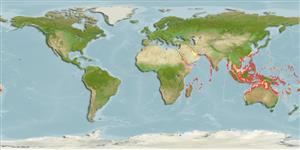Environment: milieu / climate zone / profondeur / distribution range
Écologie
marin récifal; profondeur 1 - 50 m (Ref. 11441), usually 1 - 15 m (Ref. 90102). Tropical; 30°N - 31°S, 30°E - 175°W
Indo-Pacific: Persian Gulf (Ref. 68964) and Red Sea south to Mozambique and east to Fiji, north to the Ryukyu and Bonin islands, south to New Caledonia. Recently recorded from Tonga (Ref. 53797).
Taille / Poids / Âge
Maturité: Lm ? range ? - ? cm
Max length : 8.0 cm TL mâle / non sexé; (Ref. 2334); common length : 6.0 cm SL mâle / non sexé; (Ref. 37816)
Épines dorsales (Total) : 8; Rayons mous dorsaux (Total) : 9; Épines anales: 2; Rayons mous anaux: 8. Bluish silver in color, with 6 orange-yellow stripes, including a short post ocular stripe. Sub-equal along abdomen, and midlateral stripe ends into pinkish to orange spot on caudal fin base (red at night) (Ref. 48635). Greatest depth of body 2.7-3.0 in SL (Ref. 90102).
Body shape (shape guide): fusiform / normal; Cross section: compressed.
Inhabits sheltered clear water areas of lagoon and seaward reefs from depths of 1 to at least 49 m. Found in small or large aggregations under ledges, in holes, or even among long spines of sea urchins. Feeds on planktonic crustaceans and small invertebrates. Has been reared in captivity (Ref. 35404).
Mouthbrooders (Ref. 240). Distinct pairing during courtship and spawning (Ref. 205).
Masuda, H., K. Amaoka, C. Araga, T. Uyeno and T. Yoshino, 1984. The fishes of the Japanese Archipelago. Vol. 1. Tokai University Press, Tokyo, Japan. 437 p. (text). (Ref. 559)
Statut dans la liste rouge de l'IUCN (Ref. 130435: Version 2025-1)
Menace pour l'homme
Harmless
Utilisations par l'homme
Pêcheries: commercial; Aquarium: Commercial
Outils
Articles particuliers
Télécharger en XML
Sources Internet
Estimates based on models
Preferred temperature (Réf.
123201): 25 - 29.3, mean 28.4 °C (based on 3142 cells).
Phylogenetic diversity index (Réf.
82804): PD
50 = 0.5000 [Uniqueness, from 0.5 = low to 2.0 = high].
Bayesian length-weight: a=0.01318 (0.00802 - 0.02166), b=3.13 (2.99 - 3.27), in cm total length, based on LWR estimates for this species & (Sub)family-body (Ref.
93245).
Niveau trophique (Réf.
69278): 3.6 ±0.56 se; based on food items.
Résilience (Réf.
120179): Haut, temps minimum de doublement de population inférieur à 15 mois (K=2.93).
Fishing Vulnerability (Ref.
59153): Low vulnerability (10 of 100).
🛈
Nutrients (Ref.
124155): Calcium = 221 [107, 630] mg/100g; Iron = 1.71 [0.80, 3.17] mg/100g; Protein = 19 [18, 20] %; Omega3 = 0.172 [0.067, 0.456] g/100g; Selenium = 57.9 [18.9, 160.0] μg/100g; VitaminA = 41.3 [9.2, 177.0] μg/100g; Zinc = 2.95 [1.65, 4.81] mg/100g (wet weight);
